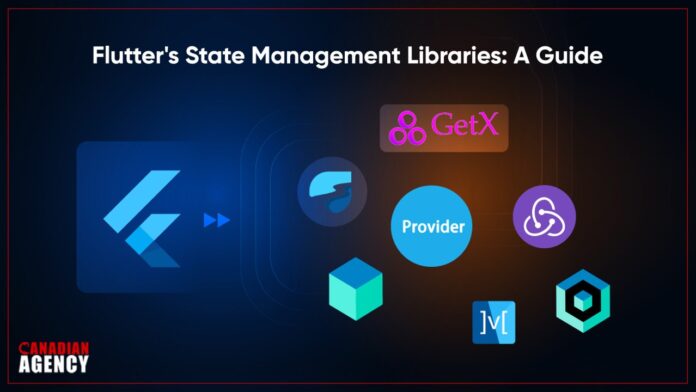Flutter is an open-source framework that allows you to build visually appealing and high-performance applications. There are various features associated with Flutter, which makes it the best framework to choose for developing applications and deploying on multiple platforms with identical codebases. Moreover, Flutter features like hot reload, widgets library, native-like experiences, and faster time to market enhance user experiences and business. However, one of the fundamental aspects of developing applications is the management of the State. By managing the State effectively, Flutter applications can deliver a seamless user experience by adapting dynamic user experience and maintaining scalability. In this article, we’ll break down the concept of best state management in Flutter in a simple and accessible way.
What is State Management in Flutter?
State management is one of the vital concepts in the Flutter framework for developing robust, high-performing, and responsive mobile applications. It is a technique that is used to handle and change data within the application to ensure that your application accurately displays the current state. It is essential for developing innovative and complex applications where data might flow across multiple screens and interact with user actions.
Importance of Best State Management in Flutter
The following are the significance of state management for the Flutter software development kit.
For Maintaining User Interface Consistency
When your organization changes data within the app, the user interface must display these updates accurately. The state management will ensure the user interface appropriately shows the updated data.
Data Access Across Widgets
When your organization requires sharing data across different parts of applications, effective state management becomes essential. State management provides a mechanism for widgets that will enable accessing and reacting to changes in shared data. It allows seamless communication between various components, ensuring that updates to the data are correctly displayed in the application.
Improved Code Organization
By separating the state logic from widget building, you can shift towards cleaner and maintainable code. These libraries will help to handle data fluctuations, freeing your widgets to focus solely on user interface development.
Best Practices of State Management in Flutter
To choose the best state management in Flutter, your organization has to follow several best practices, which involve selecting a suitable approach based on your applications’ complexity and requirements.
1. Select the Right Approach
Selecting the appropriate approach is essential for effective Flutter state management. You should assess your application’s complexity and specific requirements and then select the most appropriate solution accordingly. For simpler applications, utilize built-in tools like Provider or Riverpod. In contrast, for more complex ones, opt for third-party libraries such as Bloc or MobX, which provide robust features for managing state and asynchronous operations.
2. Separation of Concerns
By keeping the concerns of State management and user interface separate, you can develop cleaner and more manageable codebases. By following this best practice, your organization can streamline development, enhance code readability, and optimize performance, resulting in scalable and efficient Flutter applications.
3. Optimize Widget Rebuilds
Effective Flutter state management is vital for optimizing performance and ensuring a seamless user experience. By minimizing unnecessary rebuilds of UI components, you can significantly enhance performance. Techniques such as const constructors or value keys can be utilized to reduce unnecessary widget rebuilds. Implementing these strategies helps ensure that your UI updates efficiently and meets the required standards for user experience.
4. Asynchronous State Handling
Handling asynchronous state effectively is a crucial component of efficient Flutter state management. By utilizing Flutter’s built-in asynchronous programming features like FutureBuilder or StreamBuilder, you can ensure smooth handling of asynchronous operations within your applications.
Types of Best State Management Approaches in Flutter
Various state management approaches are available for the Flutter framework, and the selection should be based solely on your project specifications. In case of any dilemma, you can consult a Flutter app development company to help you choose the best state management in Flutter approach for your project’s requirements and specifications. It would be best if you consider the following state management approaches while developing Flutter-based applications.
1. setState
The setState method is one of the most straightforward built-in state management approaches in Flutter. It’s well-suited for managing states within a single widget, making it ideal for smaller apps or when dealing with isolated state changes.
2. Provider
Provider is a flexible and scalable approach that offers a lightweight and intuitive solution to share state across the application using InheritedWidgets. It’s particularly well-suited for managing state in applications ranging from simple to moderately complex.
3. Riverpod
It is a powerful state management solution for creating scalable and maintainable Flutter applications by separating state management logic from UI components. It shares similarities with Provider but implements a one-way data flow to address issues such as readability, testability, and performance, among others.
4. Bloc
The Bloc architecture pattern, which is used explicitly for complicated applications, is frequently utilized for best state management in Flutter. It utilizes streams to handle and transmit state modifications while separating the user interface from business logic.
5. MobX
MobX is a state management tool in FLutter that uses a reactive programming language, and it will help the developers write the code in such a way that it responds and updates automatically in the state. It utilizes observables and reactions, which will automatically update the user interface in response to the changes in the state.
Conclusion
State management is one of the vital approaches in the Flutter framework for building robust, responsive, and high-performance applications. If your organization chooses the right approach and follows best practices, the performance of your application and user experience will improve significantly. Therefore, this article discusses the importance, best practices, and types of State management in Flutter. In case of any doubt, you can Hire Flutter developers who can guide you promptly throughout the process.


